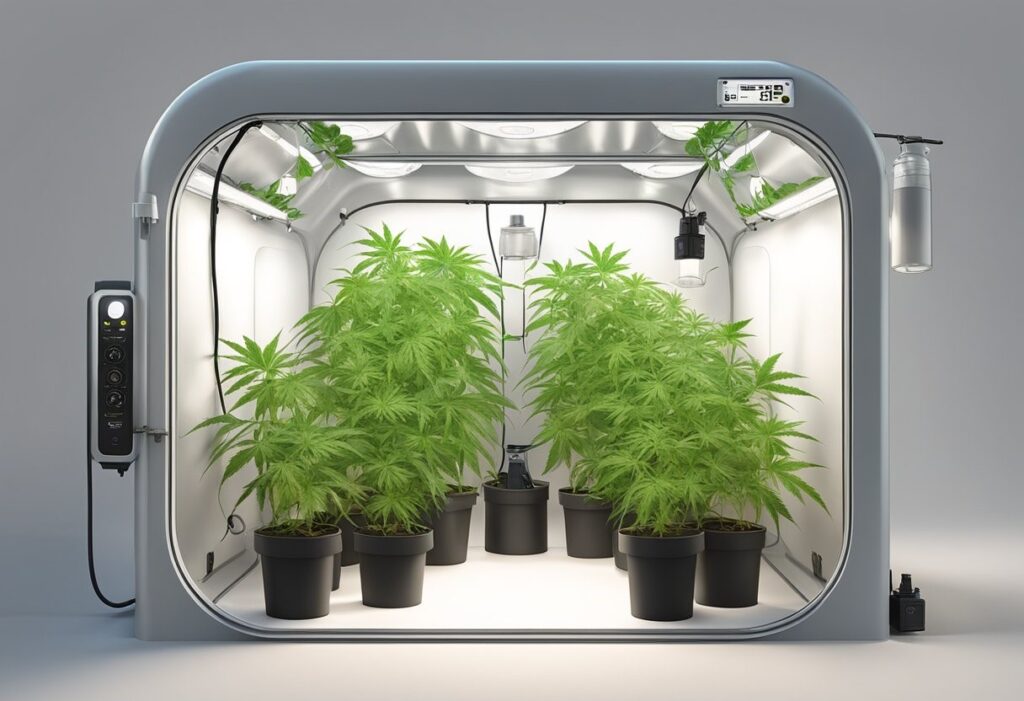
Before diving into your cultivation journey, understand that growing White Widow requires attention to its unique genetic profile, careful seed selection, precise germination, and controlled environmental conditions through all growth stages to ensure a bountiful harvest of this potent hybrid.
White Widow is a balanced hybrid, combining a Brazilian Sativa landrace and a resin-heavy South Indian Indica. It is renowned for its high THC content, often 18-25%, and is cherished for its earthy flavor and strong, complex aroma. Cultivators prize White Widow for its robust nature and good yields.
Harvest White Widow after a flowering time of approximately 8-9 weeks when trichomes have a milky appearance, signaling peak THC levels. Dry your buds properly and then cure them in airtight containers to enhance the flavor, aroma, and potency.

To achieve the best possible outcomes when growing White Widow, it’s crucial to fine-tune your cultivation practices. Whether indoors or outdoors, understanding and controlling environmental factors is key to maximizing yield and ensuring robust growth.
To maximize indoor yields, your focus should be precise control of all growth conditions. Your White Widow plants thrive with a temperature range between 75-80°F (24-27°C) and a humidity level of 60-70% during the vegetative stage. As they enter the flowering phase, lower humidity gradually to prevent mold. Lighting is paramount; high-intensity LED or HPS lights on an 18/6 light-to-dark schedule enhance vegetative growth, transitioning to a 12/12 schedule to trigger flowering.
Adjustable ventilation is necessary to maintain air circulation and CO2 availability, while at the same time a hydroponics system can offer better control over nutrient delivery and pH levels. During flowering, boost phosphorus and potassium while easing back on nitrogen. Make sure your pH remains between 6.0 and 7.0 to facilitate optimal nutrient uptake.
While growing White Widow outdoors can be less controllable, it can also be immensely rewarding. Choose a spot with ample sunlight and shelter from extreme weather. Climate plays a vital role; White Widow prefers a mild to warm temperature, ideally staying above 70°F (21°C) even during nights.
Invest in your soil quality by ensuring it’s rich and well-draining, with a gentle slope if possible, to prevent water accumulation. Regular soil testing allows you to adjust pH levels which should stay around 6.5 to 7.0 to protect against nutrient lockout. While nutrients occur naturally, supplementing with added nitrogen during vegetative growth, and phosphorus and potassium during the flowering phase, reinforces plant strength and yield. Monitor plants for pests and diseases, a crucial part of maintaining plant health.

White Widow is a widely recognized strain known for its high THC content and distinctive balance of effects. Whether you’re seeking relief from medical symptoms or looking for a boost in your recreational experiences, White Widow has a variety of applications to suit your needs.
Recreationally, White Widow is favored for its potent effects that induce a state of euphoria and mental stimulation. It has a unique flavor profile—comprising earthy, pine, and subtle hints of spice—due to the presence of terpenes like caryophyllene and pinene. This strain commonly leads users to feel uplifted and creative, making it a great choice for:
On the medicinal front, White Widow has several notable applications. It is often used by patients who are dealing with:
With a typically balanced ratio of Indica to Sativa, coupled with trace levels of CBD, White Widow supports a harmonious blend of physical relaxation and mental clarity, allowing you to tackle daily tasks without the heaviness that some strains might induce. Always remember to consult with a healthcare provider for advice on treating medical conditions with cannabis.
Your optimal indoor setup for White Widow includes a well-ventilated space with controlled temperature (75-80°F) and humidity (60-70%). Using full-spectrum LED lights ensures strong growth and energy efficiency.
For a basic indoor grow system, you’ll need a grow tent, full-spectrum LED grow lights, a ventilation system with carbon filters, pots or grow beds, and a reliable system to monitor temperature and humidity.
White Widow’s growth cycle typically spans about 8-9 weeks from germination to flowering, with some variation depending on your growing conditions and whether you’re cultivating an auto-flowering variety.
During the vegetative stage, your White Widow plants will benefit from a nutrient solution high in nitrogen. In the flowering stage, switch to a solution rich in phosphorus and potassium to support bud development.
Yes, White Widow can be grown outdoors. It thrives in a mild, temperate climate with consistent sunlight and well-draining soil. Protecting your plants from extreme weather and pests is crucial for outdoor grows.
We ship and deliver world wide via USPS and various couriers.
We offer a wide range of secure and anonymous online payment options.
We care about you, our customer. Please contact us with any questions or concerns.
Find out more about the benefits of being a loyal and regular customer.
WE ARE EVERY GROWERS ONE STOP SHOP TO ACQUIRE PREMIUM CANNABIS SEEDS FOR SALE IN THE USA, CANADA AND AUSTRALIA

Farmers Lab Seeds 2024, | All Right Reserved
Seeds are sold as novelty items, souvenirs, and collectibles. They contain 0% THC. We encourage our customers to check the legislation in their Country, State, Province, and Municipality prior to purchasing items from our store. We do not provide growing information.
All seeds are sold as hemp, and lab tested under 0.3% THC. This product is not for use by or sale to persons under the age of 21. This product should be used only as directed on the label. It should not be used if you are pregnant or nursing. Consult with a physician before use if you have a serious medical condition or use prescription medications. A Doctor’s advice should be sought before using this and any supplemental dietary product. All trademarks and copyrights are property of their respective owners and are not affiliated with nor do they endorse this product.
These statements have not been evaluated by the FDA. This product is not intended to diagnose, treat, cure or prevent any disease. Individual weight loss results will vary. By using this site, you agree to follow the Privacy Policy and all Terms & Conditions printed on this site. Void Where Prohibited by Law.